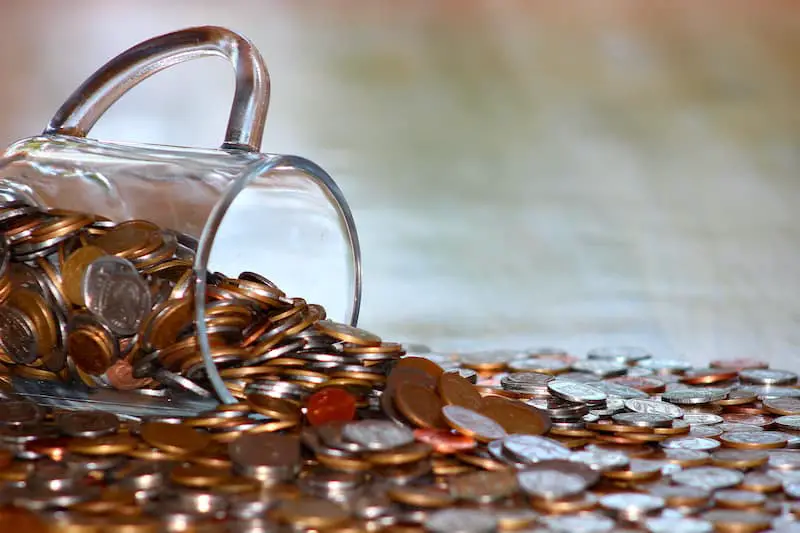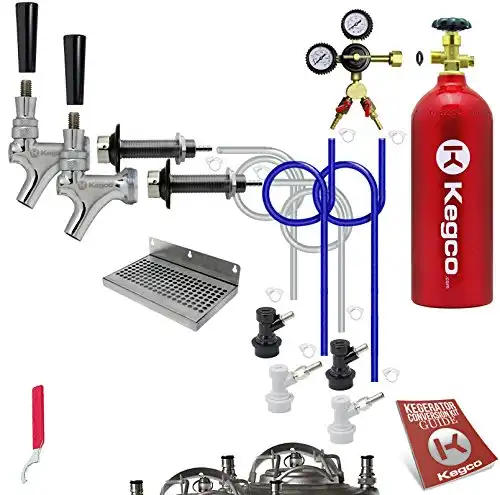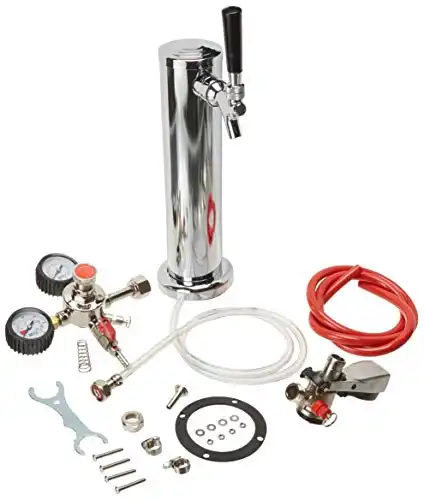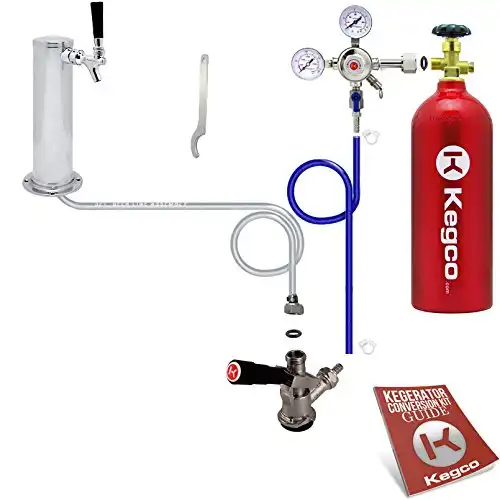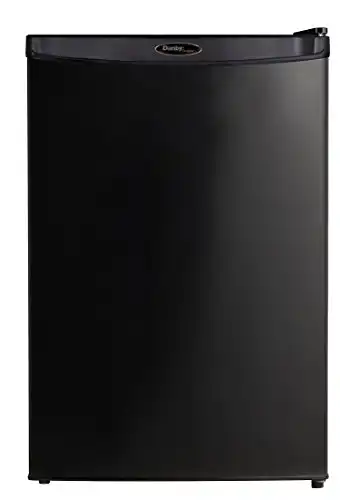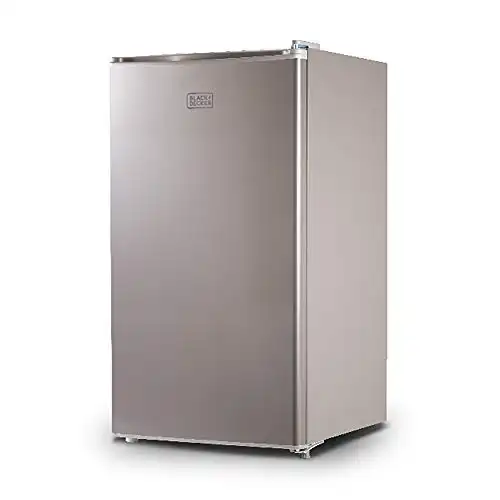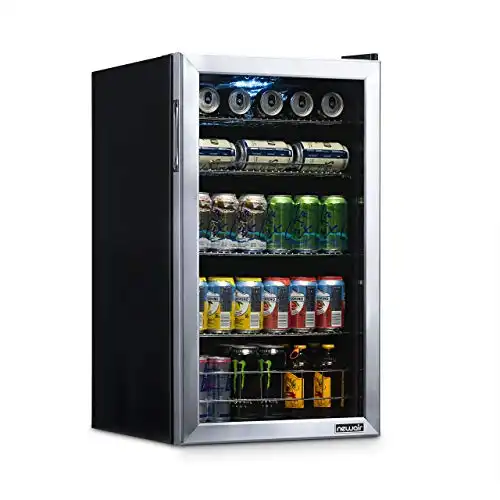A night out at your favorite brewpub or bar is fun, but it can set you back financially. A couple of craft beers once a week at the local watering hole could add up to more than $100 a month or more.
You could buy a six-pack of your favorite beer, but a draft beer in a cold pint glass or frosty mug is so much more delicious.
What’s a beer lover on a budget to do?
One option is to consider buying a kegerator to keep your favorite craft beers cold and fresh from the keg. But how much is a kegerator?
Alternatively, you can convert an existing refrigerator into a kegerator.
Either way, you can add a keg of your favorite beer and enjoy. Whether you’re drinking a beer on your own or with friends, your Kegerator can serve up a cold draft beer that’s just as good as the local craft beer taproom.
The best part is, your Kegerator or conversion Kegerator will actually save you money over time. That might make that cold beer taste even better!
What is a Kegerator?
A Kegerator is a refrigerator designed to dispense draft beer from a keg. The working parts of a Kegerator include the keg, naturally, plus a beer and air line, a CO2 cylinder, and a CO2 pressure regulator with inlet and outlet pressure gauges.
Kegerators are most often associated with beer, but they’ve also been used to dispense wine, cold brew coffee, and kombucha.
Keg-onomics
How much is a keg of beer? That depends on whether it’s a domestic, like Budweiser or Coors, an import, or a craft beer. Domestic half-barrel beer kegs start at about $100 for a full keg. Smaller kegs such as pony kegs or mini-kegs cost less but contain less beer.
Let’s compare that to the cost of a case of beer, which will cost about $25 for 24 cans. A keg of beer will hold the equivalent of seven cases of beer. It doesn’t take a mathematician to see that beer by the keg is less expensive.
How long beer will stay fresh in a keg depends on whether it’s pasteurized. Pasteurized beer will last three to six months, while unpasteurized beer lasts about two months. You shouldn’t have the problem of beer going bad before it’s enjoyed if you have a Kegerator to keep it cold and carbonated.
Cost of Buying a Ready-Made Kegerator
But how much is a Kegerator? A new Kegerator will set you back at least $700, but some models cost more than $1,000.
That may seem like a lot of cash to spend if saving money on beer is the goal, but let’s compare that to the cost of a weekly night out at the bar or brewpub. That $100 a month adds up for $1,200 a year, so that’s the cost of a Kegerator plus a keg or two of beer at least.
A Kegerator may already be starting to sound economical, but there are more ways you can save.
Cost of Building Your Own Kegerator
Kegerators sound even more frugal when we look at the cost of building a Kegerator with an existing mini-refrigerator or one you buy for the project. Conversion kits to turn a little refrigerator into a Kegerator can cost as little as $150 or less.
Top Kegerator Conversion Kits
If you’re handy or like the idea of a do-it-yourself project that will end with a cold beer, building your own Kegerator can save you even more money.
Mini-fridges to Convert into a Kegerator
If you already have a mini-refrigerator in your man cave or maybe one left over from your college dorm, then that makes a Kegerator conversion even less expensive. If not, mini-refrigerators cost about $300 or less. This makes a conversion less than half the cost of a new Kegerator.
Mini-fridges to convert into a Kegerator include this selection tested by BrewPublik:
- Danby Designer : With a 4.4-cubic-foot interior, the Danby can hold even a full-size half-barrel keg, so it’s perfect for entertaining. This mini-fridge is Energy Star compliant and doesn’t have a freezer, which makes a Kegerator conversion easier.
- NewAir Beverage Refrigerator : With a glass door, this mini refrigerator is stylish, but your keg will be on display with this 3.4-cubic-foot capacity model. It’s whisper-quiet, but the NewAir thermostat doesn’t show temperatures, only numbers. This can make setting the temperature of the NewAir tricky.
- RCA Compact Fridge : Glossy and in plenty of bright color options, the RCA compact refrigerator is light-weight, energy-efficient, and has a 3.2-cubic-foot capacity. It does have a freezer, which will make a conversion more difficult, but it’s still a good option for a Kegerator.
- HOmelabs Mini Refrigerator : HOmelabs’ mini fridge also comes with a glass door, which is fine if you want to show off the keg inside your Kegerator. At 33 inches tall and with a 3.3-cubic-foot capacity, this model can handle any size keg.
What Does a Kegerator Conversion Involve?
Follow the directions in your conversion kit for best results but turning a mini refrigerator into a Kegerator isn’t difficult if you have the tools as well as a little DIY know-how.
You’ll first have to remove the top of the refrigerator to cut through the insulation. You’ll then cut a matching hole in the top. This is where the tapper will go. Make sure you do not cut through cooling lines, as that would ruin the mini-refrigerator.
The CO2 lines will also go through the hole. These lines can be reinforced with PVC pipe if needed. You’ll then attach the CO2 lines to the tapper and the lines to the keg on the inside of the mini-refrigerator. If there’s a freezer in the mini-fridge, the conversion is similar, but the CO2 lines will go through the mini-fridge door instead of the top.
Are Kegerators Worth It?
We’ve done the math, and for beer lovers, having a Kegerator at home is definitely worth the investment.
For starters, draft beer is delicious on a hot summer day or while watching a big game. You and your friends can enjoy cold brews together whenever they come over. Your house can become a destination for friends and family, or just you whenever you’re thirsty.
Those reasons could make a Kegerator worth the costs, but then there are the savings. Your start-up costs for a Kegerator could be as low as $800, figuring in a Kegerator at $700 and a $100 keg of beer. Each pint from the first keg will cost $6.45. After that, you’ll keep using the Kegerator, so eventually, beer is the major cost.
Since beer by the keg is much less expensive than beer in cans or bottles, not to mention beer at the local pub, each keg should produce more than $55 in savings. That makes Kegerators a smart buy.
